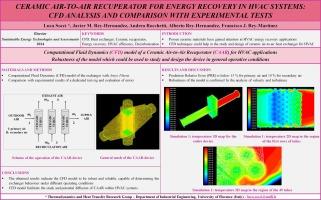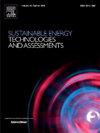用于暖通空调系统能量回收的陶瓷空气对空气换热器:CFD 分析及与实验测试的比较
IF 7.1
2区 工程技术
Q1 ENERGY & FUELS
Sustainable Energy Technologies and Assessments
Pub Date : 2024-11-14
DOI:10.1016/j.seta.2024.104082
引用次数: 0
摘要
本文探讨了陶瓷空气对流换热器(CAAR)作为暖通空调系统中能量回收装置的应用。具体而言,本文通过计算流体动力学(CFD)技术对 CAAR 进行了分析。模拟使用的软件是 Ansys Fluent。对系统的几何形状进行了细致的复制和网格划分,以生成与实际情况密切相关的三维模型。随后,在加热和冷却模式下进行模拟。将 CFD 分析结果与专用实验测试台获得的数据进行比较。观察到的预测相对误差(PRE)代表设备出口温度的相对误差,在所有模拟中,一次空气的预测相对误差始终低于 15%,二次空气的预测相对误差始终低于 10%。这些结果证实了 CFD 模型的稳健性,并为在不同运行条件下精确设计和模拟 CAAR 设备性能提供了有效工具。通过这种方式,可以为在暖通空调系统中广泛使用 CAAR 设备打开一个重要的视角,促进该行业的能源效率和去碳化。本文章由计算机程序翻译,如有差异,请以英文原文为准。

Ceramic Air-to-Air Recuperator for energy recovery in HVAC systems: CFD analysis and comparison with experimental tests
This paper explores the application of a Ceramic Air-to-Air Recuperator (CAAR) as an energy recovery device within HVAC systems. Specifically, the CAAR is analysed through Computational Fluid Dynamics (CFD) techniques. Ansys Fluent has been used as the software for the simulations. The system geometry is meticulously replicated and meshed to generate a three-dimensional model closely mirroring reality. Subsequently, simulations are conducted in both heating and cooling modes. The outcomes of the CFD analysis are compared with data obtained from a dedicated experimental test rig. The observed Prediction Relative Error (PRE), representing the relative error on the device outlet temperatures, is consistently below 15 % for primary air and 10 % for secondary air accross all simulations. These findings substantiate the assertion that the CFD model is robust and offers an effective tool for accurately designing and simulating the CAAR device performance under different operative conditions. In this way, it is possible to open up an important perspective on the widespread utilisation of the CAAR device in HVAC systems, promoting the energy efficiency and decarbonisation of this sector.
求助全文
通过发布文献求助,成功后即可免费获取论文全文。
去求助
来源期刊

Sustainable Energy Technologies and Assessments
Energy-Renewable Energy, Sustainability and the Environment
CiteScore
12.70
自引率
12.50%
发文量
1091
期刊介绍:
Encouraging a transition to a sustainable energy future is imperative for our world. Technologies that enable this shift in various sectors like transportation, heating, and power systems are of utmost importance. Sustainable Energy Technologies and Assessments welcomes papers focusing on a range of aspects and levels of technological advancements in energy generation and utilization. The aim is to reduce the negative environmental impact associated with energy production and consumption, spanning from laboratory experiments to real-world applications in the commercial sector.
 求助内容:
求助内容: 应助结果提醒方式:
应助结果提醒方式:


